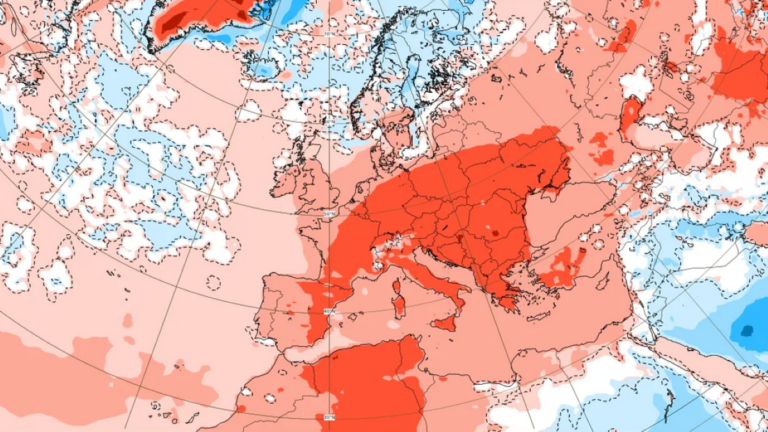
A stratospheric forecast diagram of Europe from the European Centre for Medium Range Weather Forecasts (ECMWF).
Credit: European Centre for Medium Range Weather Forecasts (ECMWF)
Credit: European Centre for Medium Range Weather Forecasts (ECMWF)
From MeteoTechInt by
The Finnish Meteorological Institute produces real-time forecast data on weather, sea, climate and space conditions and their impacts.
Physical weather, sea and climate models are a key part of the forecast value chain.
Statistical methods, including artificial intelligence (AI), have long been part of this chain.
AI has been used to enhance the use of weather observations in forecast models, for example, or to create new impact forecasts so that they identify links between meteorological phenomena and their impacts.
The atmosphere can already be modeled with data-driven AI models.
For example, the European Centre for Medium-Range Weather Forecasts (ECMWF) has developed a prototype of a data-driven global weather model that is no longer directly based on physical equations but on dependencies that the AI model has learned from a long data time series of atmospheric history, produced with a traditional weather model.

In recent years, large technology companies have taken steps forward in the development of data-driven weather forecasting methods.
The advantage of AI forecasts is their speed, compared to traditional methods.
The pre-trained AI forecast can be calculated much faster than the weather model forecast requiring a supercomputer.
In terms of quality, the weather forecasts of AI models have been at the same level as forecasts of weather models, or even better, for a few parameters and on some indicators.
The amount of data available is large and computing technology has developed
What has enabled the rapid development of data-driven forecasts? Firstly, the amount of data available nowadays is immense and it is easier to access.
For example, the Copernicus Climate Change Service (C3S) produces global re-analysis data, based on weather models and observations over several decades, which is well suited for AI methods’ training material.
Weather observations and data produced by weather models are the most important fuel in the AI forecast value chain.
Secondly, computing technology based on graphics processing units (GPU) that is well suited for training AI methods has become more common.
However, there are still shortcomings and development potential in AI forecasts.
The locally accurate re-analysis data needed to predict extreme weather phenomena, such as storms and thunderstorms, is not yet available to the same extent as ‘sparser’ global data.
The number of parameters produced by AI forecasts is also limited, compared to forecasts produced by weather models.
To mend both of these shortcomings, the inclusion of new data sources in the training of AI methods will be a key development target.
Will AI change weather forecasting?
AI has the potential to speed up weather forecasting.
Artificial intelligence can also make it possible to integrate weather impacts, such as energy production or the amount of storm damage, into the weather forecast in a completely new way.
Weather observations and weather models capable of local accuracy, which are already in operational use by the FMI and other national meteorological services, are likely to play a key role in producing new training data.
In addition, the enormous speed of data-driven forecasting methods attracts research into how the uncertainty of the forecast could be assessed more cost-effectively, using data-driven methods compared to the current ensemble forecasting technology.
However, AI models and their quality do not happen in a vacuum; they are only as good as the data used for training the methods.
Re-analysis data and the underlying weather models must continue to be developed to improve the quality of data-driven forecasting methods.
Creating and updating data, as well as training AI forecasting methods, are all computationally highly intensive activities that will continue to require supercomputer capacity.
Depicted is an eight-day forecast of 10-meter winds and surface pressure
using HR-Stormer running at 30-km.
(Video by Troy Arcomano/Argonne National Laboratory.)
It is clear that the new possibilities offered by AI will also change weather forecasting, but the possibilities and limitations of the methods and data must be understood.
The pace of development of artificial intelligence methods and their application is tremendous right now, so it is challenging to assess how great the ultimate transformation will be.
Together with its European partners, the FMI is contributing to this transformation, by developing and testing data-driven forecasting methods.
At the moment, it seems that the best results can be achieved by combining observations, physical models and AI methods to achieve more accurate and especially faster forecasts.
Investments in methodological research, as well as data and computing infrastructure, are essential to achieve the expected benefits.
Links :
- MeteoTechInt : Improving stratospheric and tropical forecasts would improve monthly forecasts for Europe, Finnish Meteorological Institute reports / European Research Council awards €2m to Finnish Meteorological Institute’s space weather research
- Bloomberg : An Ominous Hurricane Season Will Test New AI Weather Forecasting
- Argonne National Lb : Argonne develops new kind of AI model for weather prediction
- GeoGarage blog : AI quickly and accurately predicts major storms' path and ... / AI breakthroughs could improve weather forecasts / Google DeepMind's AI weather forecaster handily beats a global ... / The danger of leaving weatherprediction to AI / Google AI model outperforms traditional methods of ... / IBM extends NASA collaboration to apply generative AI ... / Algorithms in the Arctic – removing bad weather from ... / How NASA, NOAA and AI might save the internet from ... / New model based on Artificial Intelligence available in ... / Tracking hurricanes with artificial intelligence / Satellites and AI can help solve big problems—if given the ...
No comments:
Post a Comment